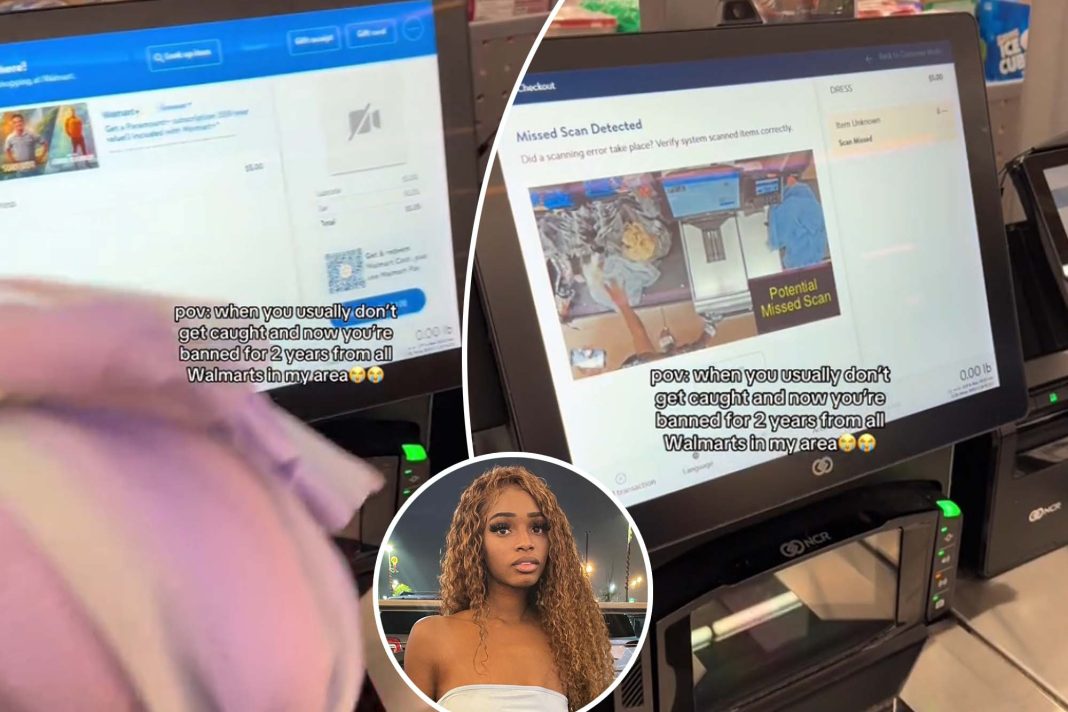In a rather audacious display of disregard for retail ethics, a TikTok user named Nesha recently shared a video depicting her own shoplifting attempt at a Walmart self-checkout. The clip has since gone viral, garnering over 2.2 million views, and serves as a cautionary tale about the evolving intersection of technology, theft, and social media.
The video opens with Nesha casually scanning a few items before nonchalantly attempting to place a backpack in her shopping bag without actually scanning it. Moments later, the self-checkout system activates a notification: “Associate is on the way.” This alert prevents her from proceeding with the transaction, prompting a store employee to intervene. As the employee scans her purchases, the screen displays a “Missed Scan Detected” message, corroborated by video footage of Nesha’s blatant attempt to bypass the scanning process.
In a twist of irony, as the employee calls for the manager and police, Nesha captures the moment with her camera, showcasing the employee laughing at the situation. Despite the lighthearted demeanor, the gravity of the incident is undeniable; Nesha was subsequently banned from all Walmart locations in her area for two years.
This incident sheds light on a troubling trend in retail spaces, particularly at self-checkouts, where approximately 15% of shoppers admit to having stolen items, according to a 2023 survey by LendingTree. Interestingly, of those who confessed to theft, only a third reported being caught. This statistic underscores a concerning reality: the anonymity and perceived safety of self-service systems often embolden shoppers to act against their better judgment.
In response to the rising tide of theft, Walmart has ramped up its anti-shoplifting strategies, reportedly losing around $3 billion annually due to theft. Artificial intelligence has become a cornerstone of these efforts, with innovations like “Missed Scan Detection” being implemented since 2017. This technology utilizes AI-powered cameras to monitor transactions and identify potential theft in real-time. The latest advancement includes the integration of nearly invisible barcodes on store-branded items, allowing for seamless scanning without the need to directly scan each individual barcode. This initiative is part of a $3 million partnership with Digimarc, aimed at bolstering the company’s defenses against inventory losses.
Despite these advancements, some Walmart locations have experienced persistent theft issues, leading the retailer to consider eliminating self-checkout options altogether in certain areas. The company has indicated that these measures are part of a broader strategy to enhance the in-store shopping experience, even as it grapples with the challenges posed by theft.
In a statement reflecting its stance, a Walmart spokesperson noted, “We do not publicly disclose security measures in our stores.” This level of discretion is likely a tactical choice, aimed at maintaining the effectiveness of their security protocols while navigating the ongoing battle against retail theft.
While Nesha’s TikTok escapade may appear humorous on the surface, it serves as a stark reminder of the complex realities of modern retail. As technology continues to evolve, so too do the methods and motivations behind theft. This incident not only highlights the risks associated with self-checkout systems but also raises critical questions about accountability and the ethical implications of social media in sharing such experiences.
For consumers, the narrative is clear: the thrill of getting away with a theft may be fleeting, but the consequences — both legal and reputational — can be lasting. As the landscape of retail continues to shift, it’s essential for shoppers to consider the broader implications of their actions and the evolving strategies employed by retailers to combat theft in an increasingly digital age.
